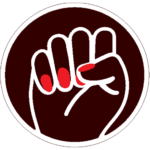Don’t slip out the back, Jack, but do make a new plan, Stan. Yes, we’re taking some liberties with that old song, but our version of the lyrics makes for a perfect intro to “50 Ways to Fight Bias” — or, in our preferred rendition, “50 Ways to Leave Your Bias” — a brand new guide for managers and individuals looking to challenge bias in the workplace, whether deliberate or unconscious, whether macro or micro.
A little bit of simple math goes a long way towards illuminating the importance of this issue: 73 percent of women experience bias at work but less than one-third of employees are able to recognize said bias when they see it. So, most women run into bias at work and most people don’t see it. For those in the way way back who can’t see the board, the solution to this mathematical conundrum is that the vast majority of workers need anti-bias training. Prejudice, particularly the kind that’s hard to identify by those not on the receiving end, is all around all the time in every workplace. It is a huge impediment to women’s career advancement and to companies looking to level the playing field.
In order to address ubiquitous bias in the workplace — and in keeping with this year’s International Women’s Day theme, #ChooseToChallenge — Lean In and the International Women’s Day website developed a solutions-oriented plan for educating employees on bias and how to take action against it. In one of the intro videos included in the guide, Lean In President Rachel Thomas stressed that absolutely everyone has unconscious biases: “Our brains take in more information than they can process, so we rely on mental shortcuts to simplify the world around us, which means we rely on stereotypes.” [Check out Harvard’s Implicit Association Test — here’s the analysis specifically focusing on gender in the workplace.]
Here are the most common types of bias women face at work, according to “50 Ways to Fight Bias” (yes, you will cringe/cry/roll-your-eyes in painful recognition):
✔ Likeability bias: Likeability bias is rooted in age-old expectations. We expect men to be assertive, so when they lead, it feels natural. We expect women to be kind and communal, so when they assert themselves, we like them less.
✔ Performance bias: Performance bias is based on deep-rooted — and incorrect — assumptions about women’s and men’s abilities. We tend to underestimate women’s performance and overestimate men’s.
✔ Attribution bias: Attribution bias is closely linked to performance bias. Because we see women as less competent than men, we tend to give them less credit for accomplishments and blame them more for mistakes.
✔ Maternal bias: Motherhood triggers false assumptions that women are less committed to their careers — and even less competent.
✔ Affinity bias: Affinity bias is what it sounds like: we gravitate toward people like ourselves in appearance, beliefs, and background. And we may avoid or even dislike people who are different from us,
✔ Intersectionality: Bias isn’t limited to gender. Women can also experience biases due to their race, sexual orientation, a disability, or other aspects of their identity.
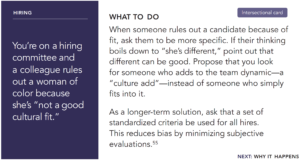 The bulk of the work in Lean In’s digital workshop is centered on exercises focused on situations when bias is most likely to surface — during hiring and promotions, for example — and why it’s problematic in these instances and how to handle it.
The bulk of the work in Lean In’s digital workshop is centered on exercises focused on situations when bias is most likely to surface — during hiring and promotions, for example — and why it’s problematic in these instances and how to handle it.
Catalyst, another nonprofit advocating for workplace equality, is also focusing on recognizing bias in support of this year’s #ChooseToChallenge International Women’s Day.
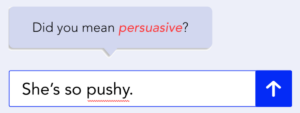
Its campaign includes several tools to raise awareness of unconscious bias, including perhaps the most awesome Slack plugin ever, #BiasCorrect, which is described as “spell-check but for gender bias” (see image).
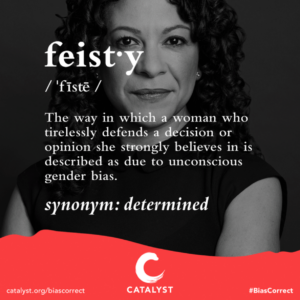
Catalyst also built a photo generator to highlight the differences between what women are commonly labeled at work versus men. Women upload a photo of themselves and add an adjective that’s been used in the workplace to describe them due to unconscious bias (e.g. “feisty”). Men are encouraged to be allies by uploading photos of themselves along with the words used to describe them at work (e.g. “determined”), the idea being that as these photos get shared across social channels, people will begin to see how the same qualities are characterized in very different ways depending on gender.
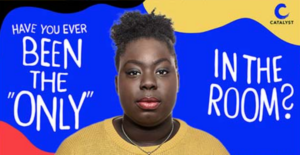
And, Catalyst created downloadable virtual backgrounds that underscore the “invisible barriers” holding back women professionals, and particularly women of color. So now if someone needs to zone out a bit during a Zoom meeting, they can feast their eyes on your thought-provoking background, which might read “Have you ever been the ‘only’ in a room?” or “Have you ever been talked over in a meeting?”
We are huge fans of how both Lean In’s “50 Ways to Fight Bias” and Catalyst’s #BiasCorrect campaigns are very action-oriented and we look forward to making use of their tool sets throughout Women’s History Month and the rest of the year — because every day is International Women’s Day at Boss Betty! 